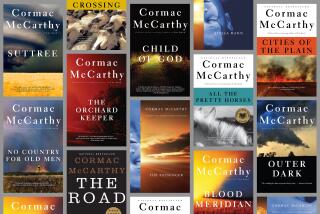O’Brian’s ‘Road’ is worth the trip
- Share via
IN reissuing Patrick O’Brian’s 1954 novel “The Road to Samarcand,” the late British author’s publishers remind us of the secret of his success. He knew how to tell a story.
Maybe it’s a talent special to those islands off the northwest coast of the European continent, watered by Atlantic mist and three major and a few minor supple languages. Maybe it’s a way of passing the long, damp seasons. More likely, as the anthropologists tell us, storytelling is a device to make some sense of multiple perceptions that, taken individually, produce childhood confusion.
Perhaps, too, this storytelling talent shared by generations of British writers has something to do with empire. Since there was very little in the world the British did not control, there were few boundaries to the play of their imaginations.
O’Brian was the kind of British writer with a special taste for adventure among people who speak exotic tongues and live in places that appeal to the imaginations of adolescent boys. Not that he wrote just for “young adults,” though people of that age may happily enjoy his work along with octogenarians.
O’Brian’s specialty, displayed to best effect in his series of 21 Aubrey-Maturin novels (including the swashbuckling “Master and Commander”) is the classic weaving of plot and character presented in a tapestry of elegant 18th century English richly (and sometimes roughly) drawn from the Royal Navy, whose struggles with Napoleon set the stage for a panoply of action on the high seas.
It will be of interest to see how well “The Road to Samarcand” sells in an age when Central Asia is not merely a playing-board square for a fireside game of strategy but a real region of blood, tears and death for Briton and American alike.
The novel opens in the style familiar to all fans -- may we say friends? -- of O’Brian: “The Wanderer ran faster with the freshening of the breeze; her bows cut into the choppy sea, throwing white hissing spray into the sunlight. The schooner was carrying every stitch of canvas that she could spread, and she was so close into the wind that the boy at the wheel kept glancing up at the sails, watching for them to shiver and spill the breeze; but they remained taut and full, and presently his attention faltered. His gaze went up past the dazzling white triangles of the sails to the great albatross above them.”
This reveals the essence of O’Brian’s style, to which he held fast until his death in 2000: a rattling good adventure story, generally set at sea, told with a sharp eye for the revealing detail about a human being in an uncertain setting in which danger would certainly be revealed. Who could fail to accept an invitation to curl up with such a book?
When O’Brian wrote “The Road to Samarcand” in the 1930s, he had not yet settled on the Royal Navy in the age of Adm. Horatio Nelson as the arena for his characters. So instead of chronicling England’s fight to master the seas, and thus the world, the author takes us from the South China Sea to East and Central Asia, to Tibet and China’s satisfyingly mysterious interior in search of ancient treasures.
We travel with Derrick, a teenage orphan of missionary parents, who accompanies his captain uncle and an elderly cousin on an archeological expedition in the 1930s to the Mongol despot Tamerlane’s 14th century capital (now a city in Uzbekistan). Along the way, they are hijacked, endure the heat of the Gobi Desert and the frigid snows of Tibet, and encounter Russian agents and Chinese bandits.
The novel’s first chapter alone is worth the price, a description of a typhoon that Joseph Conrad himself would have been proud to publish.
“[T]he Wanderer was climbing the back of a huge wave, with her nose pointing at the sky, and the water on the fo’c’sle surged back and carried him with it.... Again and again the great following seas smashed over the schooner’s stern, and each time she wallowed under a sheet of water and spray. But each time, after the spray had half drowned them, she would rise, the water shooting from her scuppers, lighten herself and speed on.”
No one was quite like Patrick O’Brian. Now W.W. Norton shares his rich, adventurous storytelling with a new American audience.
--
Anthony Day is a former editor of the Los Angeles Times editorial pages.
More to Read
Sign up for our Book Club newsletter
Get the latest news, events and more from the Los Angeles Times Book Club, and help us get L.A. reading and talking.
You may occasionally receive promotional content from the Los Angeles Times.








